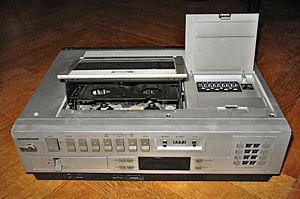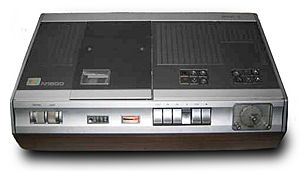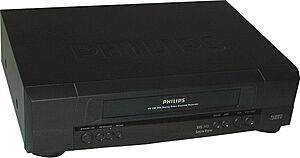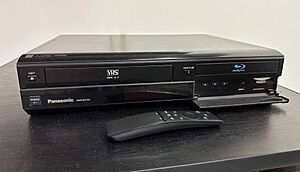Videocassette recorder facts for kids
A videocassette recorder (VCR) is an electronic machine that records and plays back video and sound. It uses special tapes called videocassettes. You could record TV shows to watch later, which was called time shifting. VCRs also played movies you bought or rented, especially in the popular VHS format. People also bought blank tapes to record their own videos.
VCRs became less popular in the 2000s. In 2016, the last company making them stopped production.
Contents
The Story of VCRs
Early Video Recorders
The idea of recording video started a long time ago. In 1956, a company called Ampex made the first successful video recorder for TV stations. It was huge and cost a lot of money, about $50,000! Only big TV networks could afford it.
In 1959, Toshiba created a new way to record called "helical scan." This method was used in later VCRs, including those that used cassettes.
By 1963, companies like Philips and Sony started making smaller video recorders. These were for businesses, schools, and even some homes.
First Home Video Machines
The very first home video recorder was called the Telcan. It was made in the UK in 1963. You could buy it already built or as a kit to put together. It was expensive and could only record for 20 minutes at a time. It recorded in black and white, as color TV wasn't common yet.
In 1965, Sony released its first VCR for home use, the CV-2000. It was smaller and easier to use.
Over time, many things that used open reels, like audio tapes and film, changed to cassettes. This made them much more convenient for people to use at home.
In 1972, movies on videocassettes became available for home use with a system called Cartrivision. But it was still very expensive. Rental tapes were special and could only be rewound at the store.
Sony U-matic System
Sony showed a new video cassette idea in 1969. They worked with other companies to create a standard system. In 1971, they launched the U-matic system. It was the first commercial videocassette format. These cassettes were larger than later VHS tapes. They could record for up to 80 minutes.
U-matic VCRs were easy to use. They became popular in TV newsrooms, schools, and businesses. But they were still too expensive for most families. A TV/VCR combo cost about $1,395 in 1971.
Philips "VCR" Format
In 1970, Philips developed its own home video cassette format. It was called "Video Cassette Recording" or "N1500." It became available to buy in 1972.
VCRs Become Super Popular
The 1980s were a huge time for VCRs! More and more people bought them. By 1982, 10% of homes in the UK had a VCR. By the end of the 1980s, over half of British homes owned one.
VHS vs. Betamax: The Format War
Two main types of VCRs fought for sales: Sony's Betamax and JVC's VHS. This competition was known as the "format war."
Betamax came out first in November 1975. Many people thought Betamax had better recording quality. But in the end, VHS won the format war and became the most popular choice.
VCR Problems
VCRs could be sensitive to changes in temperature and moisture. If a VCR or tape moved from a warm place to a cold one, water could form inside. This is called condensation.
Later VCRs had a "dew warning" system. This would stop the machine from working if it detected moisture. If moisture was present, the tape could stick to the spinning parts inside. This could damage the tape and even the VCR itself.
Also, the magnetic tapes could get damaged when they came out of the machine. Over time, rubber parts inside the VCR could wear out, causing problems.
Why VCRs Disappeared
In the late 1990s and early 2000s, DVDs came along. DVDs were a new way to watch movies and quickly became more popular than VHS tapes. DVD recorders and other digital video recorders also became cheaper. This made VCRs seem old-fashioned. By June 2003, more people were renting DVDs than VHS tapes in the United States.
Because fewer people wanted VCRs, companies stopped making them. By 2016, Funai Electric, the last company still making VHS recorders, announced they would stop production.
Later, Blu-ray Discs became the new high-definition format. Some companies even made VCR/Blu-ray combo players. This allowed people to watch their old VHS tapes and new Blu-ray movies on one machine.
How VCRs Recorded Sound
VCRs recorded video and sound onto magnetic tape. For high-quality sound, the VCR heads had to be very precise. If they weren't perfectly aligned, the sound might have a low buzzing noise.
Different Types of Video Recorders
Most camcorders made in the 20th century also had a VCR built in. These camcorders usually used smaller tapes like 8 mm, VHS-C, or MiniDV. They didn't have timers or TV tuners like home VCRs.
In the 21st century, digital recording became the new standard. Camcorders stopped using tapes and started saving videos onto DVDs, internal memory, hard drives, or SD cards.
See also
 In Spanish: Videograbadora para niños
In Spanish: Videograbadora para niños
- Telerecording
- TV/VCR combo
- VCR/DVD combo
- Kinescope
- Write protection
- Sony Corp. of America v. Universal City Studios, Inc.
- Blu-ray Disc








